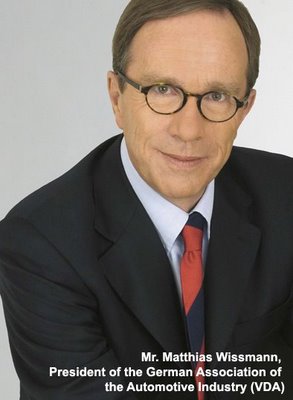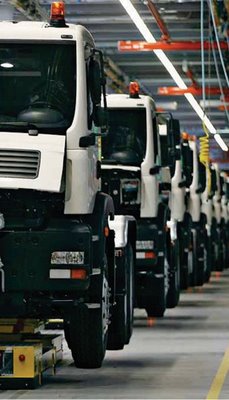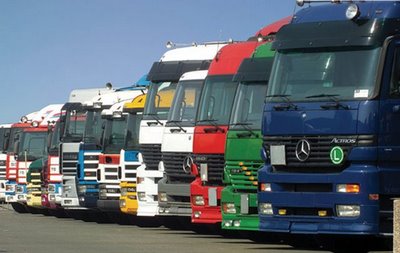The world’s most important mobility trade fair, the 62nd IAA Commercial Vehicles in Hanover, from September 25 to October 2, will set new records for the number of exhibitors and countries represented as well as the amount of exhibition space occupied, according to Matthias Wissmann, President of the German Association of the Automotive Industry (VDA).

Speaking to journalists from all over Europe at the VDA’s International Press Workshop on commercial vehicles in Frankfurt, Wissmann said the number of exhibitors would be around 2,000, up by one quarter over the previous record set at IAA in 2006. The total exhibition space will be 2,75,000 sq. m., 10 per cent more than it was two years ago. So IAA is impressively emphasizing its leading position among the world’s mobility trade fairs.
Organized by VDA, the fair will again be the ideal platform for exhibitors and professional visitors to initiate business and conclude contracts. Wissmann stressed: “There is no other commercial vehicle trade fair with more innovations or more vehicle presentations.”
Furthermore, this IAA will address comprehensively the questions of sustainable mobility and transport efficiency. The IAA’s headline is “Commercial Vehicles: On the move for everyone.”
Wissmann said: “We want this to underscore again the essential role played by commercial vehicles in delivering people’s everyday supplies and in enabling business to function. All of us should consider that having fresh vegetables in the supermarket, for example, requires the use of trucks, even if some motorists don’t like the trucks when they are on the freeways.”
However, trucks will “not be able to move all our freight traffic on their own” which, according to forecasts, will increase by 50 per cent in Germany and Europe in the next 15 years. He said: “All modes of transport are going to be needed – trucks, railroads and inland waterways. The trench warfare between them is now finally a thing of the past, and each one should exhaust its potentials, both individually and in combination. There is enough transport available for everyone.”
But it is also clear that owing to their flexibility trucks cannot be replaced by other modes of transport in many applications. The same is true of buses in local public transport as there are no alternatives, especially in rural areas. For longer journeys buses have proved their worth over many years and are the Germans’ third most popular means of travel, after cars and airplanes.

Wissmann emphasized that commercial vehicles would make a contribution to the sustainability of the transport systems and thus also to CO2 reduction. The important thing here is not only the most advanced vehicle technology, but optimizing the use of vehicles, anticipatory driving and, above all, the urgently needed investments in the traffic infrastructure.
Emissions
CO2 emissions from German road freight traffic per tonne km were reduced by around one-third in the period from 1991 and 2004 alone. There is more potential available, so that by 2025 another reduction of one-third is expected. The CO2 output from coaches is only somewhat over 30 grams per person km making them the “most climate-friendly mode of transport” today.
To further improve the CO2-efficiency of commercial vehicles manufacturers are working on optimizing the conventional diesel powertrain and transmission, reducing rolling resistance and the further development of hybrid technology and CNG propulsion.
Wissmann remarked that commercial vehicles already have a high level of passive safety. The priority now is to improve active safety with the aim of avoiding accidents altogether. ESP alone could reduce the total number of serious truck accidents by around 10 per cent. Equipping the truck fleet with distance-regulated ACC could bring down the number of serious rear-end truck collisions on the freeways by up to 70 per cent, lane departure warning systems could prevent about one-half of the accidents in which vehicles leave the carriageway.
However, not enough vehicles have such systems yet, and the equipment now available is not being used frequently enough. In the VDA’s “Safety Truck” initiative the manufacturers and their partners are therefore making a joint attempt to improve the rates of installation by offering a safety package at an affordable price in combination with discounts on vehicle insurance. This initiative could gain extra impetus if the policy-makers were to introduce appropriate incentives. One starting point could be the 600 million euro package that was pledged as compensation to the freight transport business when the truck toll was introduced.
Wissmann appealed for sustainable expansion of the transport infrastructure: “It is no help at all if vehicles become more and more economical, but consume more and more fuel because they get stuck in congestion and slow-moving traffic.”
He welcomed the planned 300 million euro increase in investments in trunk roads for the coming year, but added, “however, we have a marked concurrent rise in the truck toll, which will bring over one billion euro extra into the public coffers in the coming year alone.”
Under the new finance plan, investments in trunk roads will fall back to below today’s levels as early as 2011, despite the toll revenues pouring in.
Wissmann underscored: “We urgently need to remove the toll revenues from the ‘federal budget shunting grounds’ and allocate them directly to a trunk road company.” This is the only way to ensure the urgently needed investments in trunk roads at a sufficient level on an ongoing basis.
Hike in costs
The planned increase in the German truck toll will lead to a tangible hike in the costs of transport and logistics. The European Commission’s plans for incorporating environmental and congestion costs in the toll – without any offsetting of existing taxes and levies – would cause additional “cost burdens.”
Wissmann emphasized: “The avalanche of costs currently rolling towards the freight transport industry owing to the high diesel prices and the new general political conditions will not remain without effects on the commercial vehicle market.”
The costs of using a truck have risen by 12,000 euro within one year just because of the higher diesel prices. The industry sees around 3,000 forwarding companies in Germany at risk of going bankrupt as a result of this increase in the price of diesel. “Therefore the policy-makers should reconsider whether they have really chosen the right path for increasing Europe’s competitiveness as intended in the Lisbon Strategy, with more and more new costs on trucks.”
A growth industry
In a global view the commercial vehicle industry is a growth industry. In 2007 production rose, for the sixth year in succession, by six per cent to 11.7 million units. The production sites in Asia and Central and Eastern Europe are becoming ever more important. The commercial vehicle mar
ket in India, for example, has trebled in size over the last five years. And global commercial vehicle production is expected to grow in the current year, Wissmann declared.

With the exception of North America and Japan, the international commercial vehicle markets are still in good shape. In the US the weak development of the previous year, triggered by the anticipation of stricter emissions regulations, continued into the initial months of 2008. Sales of medium-weight vehicles fell by 19 per cent in the first half-year, while sales of heavy vehicles in Class 8 were down by 25 per cent.
However, in the second half of 2008 and in the coming year we can expect better commercial vehicle sales again – not least owing to the further tightening of emissions regulations in 2010.
The heavy commercial vehicle market in China expanded by 37 per cent up to May and therefore has a rate of growth only just under that seen last year. Russia’s market for heavy commercial vehicles, which grew by 48 per cent in 2007, will expand by 14 per cent in the current year, while the market for heavy trucks in the Mercosur states has expanded by 32 per cent so far this year.
In the new EU member-States sales up to May this year were up by 17 per cent. In Western Europe new registrations in the segment over 6 t have gone up by 12 per cent since the beginning of the year. In the second half of this year a normalization in sales and with it a rise of two per cent is expected in the heavy classes.
Sales of two million units in the van segment may be slightly below the previous year’s level, but they are still more than 30 per cent above the average of recent years. The heavy segment expects sales exceeding 350,000 commercial vehicles, which will be a new record.
Wissmann further emphasized: “The healthy position of the German manufacturers in the growth centers of Central and Eastern Europe and the German group brands’ attractive range of models have ensured market successes in an environment where industry is developing dynamically.”
The value of exported commercial vehicles has risen by an average of 14 per cent in each of the last two years. And the stable development has continued in the initial months of this year. For example, the German manufacturers were able to participate fully in the strong commercial vehicle business and push up their exports by 20 per cent in the first half-year.
Wissmann said the dynamic economic development in Germany has now slackened off somewhat following the longest-ever phase of strong expansion. But industry and the construction business still support overall demand, and the need for transport will continue to grow in the medium and long term.
On the domestic market the German commercial vehicle business has now entered the long-awaited period of normalization. In the first half of 2008, 170,000 commercial vehicles were sold, i.e., five per cent more than one year ago. This growth is due to the van segment (+9 per cent), whereas new registrations of heavy trucks fell slightly by three per cent to about 50,000 vehicles.
In 2008 as a whole new registrations in this weight class are expected to be slightly below the value recorded in the very strong preceding year, but should still exceed the average volume of the last 15 years by around 20 per cent. Total sales of vans should actually rise again. However, the trends in fuel costs and the politically motivated additional costs could put the brakes on rather more firmly.
Thanks to the strong foreign business, in the first half of this year more vehicles rolled off German production lines than ever before. Van production went up by another 15 per cent to 168,000 units, and in commercial vehicles over 6 t production expanded by nine per cent to 106,000 units.
According to Wissmann, the healthy economic situation is also noticeable in employment. In April the German automotive industry employed roughly 756,000 people, i.e., 15,500 more than it did one year before. This growth is especially due to the commercial vehicle business, where the number of employees has increased in the last 12 months by over 9,000 to 217,000.
Foreign production by the German van manufacturers climbed in the first five months of this year by 17 per cent to 129,600 units, with the highest growth rates in Central and Eastern Europe (+25 per cent) and Latin America (+30 per cent). In the segment over 6 t foreign production was up by three per cent to 153,000 units. Apart from North America, where production was reduced, foreign production of heavy commercial vehicles rose by a whole 25 per cent.
The German bus manufacturers increased their domestic production by seven per cent in the first six months of the year. This growth was fed by the rising domestic demand. New registrations were up by 13 per cent, while exports fell slightly by three per cent.
The German manufacturers now build nine out of 10 buses in other countries. In the first four months of 2008 they produced 25,400 vehicles, 14 per cent more than they did one year ago. Bus production was expanded by almost a quarter in Latin America and by 13 per cent in Europe.
The German trailer and body industry is also entering a phase of normalization after the boom of recent years. Yet sales remain at a high level. Up to May both domestic and foreign turnover had risen by 17 per cent. More than 143,000 trailers have been sold on the domestic market since the beginning of this year, which corresponds to the 2007 level.